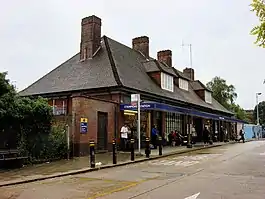| Stanmore | |
|---|---|
 | |
 Stanmore Location of Stanmore in Greater London | |
| Location | Stanmore |
| Local authority | Harrow |
| Managed by | London Underground |
| Number of platforms | 3 |
| Accessible | Yes[1] |
| Fare zone | 5 |
| London Underground annual entry and exit | |
| 2018 | |
| 2019 | |
| 2020 | |
| 2021 | |
| 2022 | |
| Railway companies | |
| Original company | Metropolitan Railway |
| Key dates | |
| 10 December 1932 | Opened (Metropolitan Railway) |
| 1936 | Goods yard closed[7] |
| 29 November 1939 | Transferred to Bakerloo line |
| 1 May 1979 | Transferred to Jubilee line |
| Other information | |
| External links | |
| WGS84 | 51°37′10″N 0°18′10″W / 51.61944°N 0.30278°W |
Stanmore is a London Underground station in Stanmore. It is the northern terminus of the Jubilee line and the next station towards south is Canons Park. The station is on the south side of London Road (part of the A410) and is in Travelcard Zone 5.
History
Stanmore station was opened on 10 December 1932 by the Metropolitan Railway (now the Metropolitan line).[8] The station building and those on the branch were designed by the Metropolitan Railway's architect, Charles W. Clark, in the suburban style used on the company's other post-First World War stations such as those on the Watford branch. The introduction of fast, direct trains into London attracted commuters to the Metropolitan Railway and presented competition for the London, Midland and Scottish Railway, who operated a rival train service from Stanmore Village railway station approximately 0.62 miles (1.00 km) away. The slower LMS trains ran on the Stanmore branch line as far as Harrow & Wealdstone, where they connected with London-bound services, but after 20 years of competing with the Metropolitan line, the Village station was closed by British Railways in 1952.[9]
In 1934, a proposal to extend the Metropolitan line northwards was discussed by the London Passenger Transport Board's Engineering Committee as an alternative or complementary scheme to the extension of the Northern line from Edgware. It would have required 1.2 miles (1.9 km) of double track tunnel to reach the proposed station at Elstree South with Metropolitan line trains continuing to Bushey or Aldenham. A revision of the proposal in 1936, considered extending the Stanmore line to Elstree.[10] The proposals were not included in the plans eventually submitted for parliamentary approval in the LPTB's New Works Programme.
Following construction of deep-level tube tunnels between Finchley Road and Baker Street, the branch and most stopping services between Finchley Road and Wembley Park were transferred to the Bakerloo line on 29 November 1939.[8] The Bakerloo line service was transferred to the Jubilee line on 1 May 1979.[8]
In 2005, Transport for London began the construction of a third platform at the station. This was structurally complete by the summer of 2009 but could not be brought into use until new signalling equipment on that part of the line had been commissioned, the platform opening to use in July 2011.
Services
The off-peak service in trains per hour (tph) is:[11]
- 12tph to Stratford
The peak service in trains per hour (tph) is:[11]
- 18tph to Stratford
- 3tph to North Greenwich
Night Tube services:
- 6 tph Stanmore – Stratford[12]
| Preceding station | Following station | |||
|---|---|---|---|---|
| Terminus | Jubilee line | Canons Park towards North Greenwich or Stratford | ||
| Former services | ||||
| Terminus | Metropolitan line Stanmore branch (1932–1939) |
Canons Park towards Baker Street or Aldgate | ||
| Bakerloo line Stanmore branch (1939–1979) |
Canons Park towards Elephant & Castle | |||
Connections
London Buses routes 142, 324 and H12 and night route N98 serve the station.[13]
See also
- Stanmore Village railway station, a main line station to the south-west closed to passengers in 1952 and completely in 1964
References
- ↑ "Step free Tube Guide" (PDF). Transport for London. April 2021. Archived (PDF) from the original on 15 May 2021.
- ↑ "Station Usage Data" (CSV). Usage Statistics for London Stations, 2018. Transport for London. 23 September 2020. Archived from the original on 14 January 2023. Retrieved 11 October 2023.
- ↑ "Station Usage Data" (XLSX). Usage Statistics for London Stations, 2019. Transport for London. 23 September 2020. Archived from the original on 9 November 2020. Retrieved 9 November 2020.
- ↑ "Station Usage Data" (XLSX). Usage Statistics for London Stations, 2020. Transport for London. 16 April 2021. Retrieved 1 January 2022.
- ↑ "Station Usage Data" (XLSX). Usage Statistics for London Stations, 2021. Transport for London. 12 July 2022. Retrieved 7 September 2022.
- ↑ "Station Usage Data" (XLSX). Usage Statistics for London Stations, 2022. Transport for London. 4 October 2023. Retrieved 10 October 2023.
- ↑ Hardy, Brian, ed. (March 2011). "How it used to be – freight on The Underground 50 years ago". Underground News. London Underground Railway Society (591): 175–183. ISSN 0306-8617.
- 1 2 3 Rose, Douglas (1999) [1980]. The London Underground, A Diagrammatic History (7th ed.). Douglas Rose/Capital Transport. ISBN 1-85414-219-4.
- ↑ "The Harrow and Stanmore railway". stanmoretouristboard.org.uk. The Stanmore Tourist Board. Archived from the original on 7 February 2018. Retrieved 7 February 2018.
- ↑ Beard, Tony (2002). By Tube Beyond Edgware. Capital Transport. pp. 21–22. ISBN 1-85414-246-1.
- 1 2 "CULG - Jubilee Line".
- ↑ Jubilee line joins London's busier than expected night tube | UK news | The Guardian
- ↑ "North West London bus map" (PDF). Transport for London. 10 April 2014. Retrieved 18 August 2014.